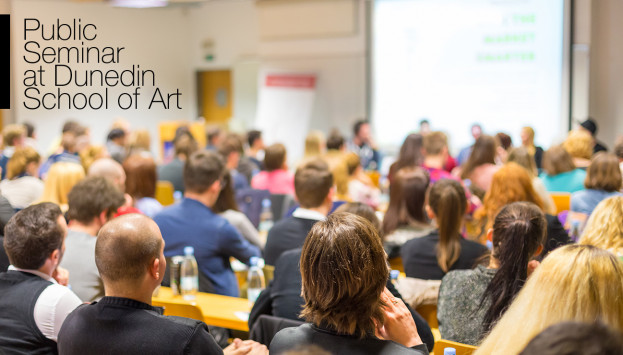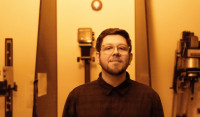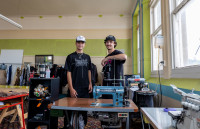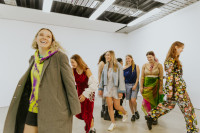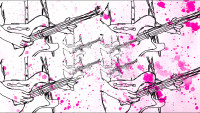1 MARCH-12 APRIL, 12:00-1:00PM, P152, DUNEDIN SCHOOL OF ART, RIEGO ST, (off Albany Street)
Public Seminar Programme for Term 1, 2018
1 MARCH, 12:00-1:00PM, P152, DUNEDIN SCHOOL OF ART, RIEGO ST, (off Albany Street)
The Ceramic Practices of Joe Bova (US) and Rob Cloughley (NZ) - Joe Bova and Rob Cloughley
The presentation by Joe Bova on his Ceramic Art is termed Form and Grace. What the I Ching says about grace is as close to a truth as I know about working with clay: "The most perfect grace consists not in external ornamentation but in allowing the original material to stand forth, beautified by being given form.”
In conjunction, Rob Cloughley will be discussing his recent work and practice that has concluded in four collaborative installations of Rob’s ceramic sculptures in combination with Prudence Edge’s Textile sculpture.
A member of the International Academy of Ceramics, Joe Bova was educated at the University of Houston (BFA, 1967) and the University of New Mexico (MA, 1969). A Professor Emeritus from LSU and Ohio University, in 2011 he was a Fulbright Fellow in Dublin, Ireland. Bova has taught workshops at institutions around the globe, including the NY State College of Ceramics at Alfred, University of Georgia’s Cortona Italy Program, Rhode Island School of Design, Archie Bray Foundation, MT, the College of William and Mary, VA, and the Shangyu Celadon Modern International Ceramic Art Center, China. His work is in many public and private collections, including the Arizona State University Art Museum, International Ceramics Studio, Kecskemet, Hungary, the National Collection of Ireland, the Los Angeles County Museum, CA, the Mint Museum of Art, NC, and the Shangyu Museum, China. Joe Bova lives and works in Santa Fe, New Mexico.
Rob Cloughley has been working with clay for 23 years. He is the Ceramic Diploma Programme Coordinator and Ceramic Studio Coordinator at the Dunedin School of Art.
8 MARCH, 12:00-1:00PM, P152, DUNEDIN SCHOOL OF ART, RIEGO ST, (off Albany Street)
Haere Mai to the Highway, a talk about a new project in painting and some of its precedents and inspirations - Tim Croucher
Recently I’ve been working on paintings that make an exchange between historical events of the colonial period, constructed incidents and my own personal memory and imagination of the places I spent my youth in the Manawatu and Rangatikei and latterly in Waikato and Thames Valley. These paintings have developed from several exhibition projects based on my trips in India and China that reflected on the dislocation and fantasy of travel.
I’ll show images of works from these projects and some source material from my current work on Haere Mai to the Highway. I’ll talk a bit about my artistic influences and methods too, if that seems relevant to the audience.
Tim Croucher was born in Longburn, just south of Palmerston North in 1963. He moved to Hamilton to finish high school in 1981, hated it, fell in love and went to Christchurch to study Fine Arts at the University of Canterbury. Tim painted public murals during the 80’s before returning, with some trepidation, to Hamilton to take up a teaching position at the Waikato Polytechnic. He’s worked there ever since teaching Fine Arts. Tim makes paintings for exhibition and shows his work regionally, nationally and internationally. He’s also recently got back into painting public artworks with his wife Tracy. When he can, he goes boating, and rides motorbikes with his family, digging around in the landscape and towns that for him, are iconic to his country.
15 MARCH, 12:00-1:00PM, P152, DUNEDIN SCHOOL OF ART, RIEGO ST, (off Albany Street)
Collections + Bits and Pieces - Andrea Daly
My grandfather was Irish living in Scotland. He worked in China where he meet his English wife, to be, and immigrated to New Zealand. He always told stories. Every night after dinner he would enthrall us with Irish Fairy tales and other wonders. Some were obviously fictional but others such as his out of body experience or the seeing of ghosts we were never quite sure about.
I think I may also be a story teller but forgot to use words. The language of the object and the visual is not one I am fluent in so it is a constant struggle and a fantastic challenge. Sometimes I know what I am saying and other times I am just concentrating on the words and an unexpected story emerges. Looking back over the 33 years of my practice I realise the underlying narrative has always been about me, my fears, interests, fascinations. I have delved into the role of being a young female trying to understand the cultural forces that define me, explored language as political, gendered, structural and constrictive. Wondered if I was an artist using jewellery as my medium or a jeweller and where were the lines and who drew them? And all the time my Catholic past keeps looking for the unexplained, unexpected and impossible. Science is like a wonderland I return to and the human brain unexplored territory, anything is possible.
But how much can a simple piece of jewellery actually tell us?
Andrea Daly is a practicing jeweler and tutor who works from her own studio and has been involved in Teaching at various institutions since 1990. She is HOD Jewellery at Hungry Creek and was a Partner in Fingers Jewellery Gallery from 1991 to 2017. She studied in Australia at Sydney College of the Arts completing an undergraduate Bachelor and Post Graduate Diploma in Visual Arts majoring in Contemporary Jewellery. She later went on to complete a Masters in Philosophy First Class Honors majoring in Art History at Auckland University. Andrea exhibits nationally and internationally with works held in both public and private collections.
22 MARCH, 12:00-1:00PM, P152, DUNEDIN SCHOOL OF ART, RIEGO ST, (off Albany Street)
Towards definitions of literacy and criticality in first year art and design courses - Steve Lovett
As students in tertiary art and design course synthesize a diverse range of information to develop concepts for their practice criticality is the core skill that they are required to develop. Steve Lovett’s current research examines definitions of literacy to include different forms of media visual cultures, text based information and communication technologies and new media, as a means to better understand literacy education in art and design programmes and therefore how to better enable the development of criticality.
Steve Lovett is an artist and educator. He set up the INKubator Print Research Lab at Manukau Institute of Technology in Auckland. In 22 years teaching in South Auckland, Lovett also designed and delivered a Foundation Education in the Visual Arts Programme. Lovett is now at Elam School of Fine Arts managing the redesign of the print facilities there.
29 MARCH, 12:00-1:00PM, P152, DUNEDIN SCHOOL OF ART, RIEGO ST, (off Albany Street)
Time-based Moving Image Installation Art and the “Cinema-Situation - Hilary Radner
Throughout most of the twentieth century, the moving image was confined to a relatively restricted set of viewing situations. Today, this is no longer the case. This intervention will consider the implications of these changes, particularly as they have been explored by the French film theorist Raymond Bellour.
Hilary Radner is Emerita Professor of Film and Media Studies in the Department of History and Art History, University of Otago. Her most recent publications include a co-edited special issue on fashion and the moving image for Fashion Theory (2017) and, with Alistair Fox, Raymond Bellour: Cinema and the Moving Image (Edinburgh University Press, 2018).
5 APRIL, 12:00-1:00PM, P152, DUNEDIN SCHOOL OF ART, RIEGO ST, (off Albany Street)
Why Art Matters: Art as Entertainment (and then some) - Patricia Hoffie
State galleries have demonstrated overwhelming success in rising to the challenge of expanding and extending Australian audiences. Crowds flow through the doors; children drag their parents and minders in to be part of the often lavish extension services programmes they offer and focus groups get special walking-talking tours through exhibitions – often for no cost at all. Along with such success there’s been a growing association of art with entertainment. And while aesthetes and purists might scoff and bemoan that development, the association is hardly a new one. Art has twinned with entertainment in its various manifestations throughout the ages, and it’s often used the close relationship as a means of raising other issues – issues that might require longer and deeper responses than quick cheap thrills.
This presentation addresses the issue of art and/as entertainment, and raising the question about the extent to which that inhibits or assists the aims of art.
Prof. Patricia Hoffie AM is a Queensland based artist, writer and curator. Trained as a painter, her practice includes a range of media including installation, assemblage and sculpture. Since her first solo exhibition in Brisbane in 1974, she has exhibited extensively in Australia and internationally For several decades her work has focused on the changing nature of work, especially in relation to shifts in understanding about what might constitute a ‘work of art’ or an ‘artwork’. She has employed the theme Fully Exploited Labour to collate several decades of practice that has examined aspects of the processes whereby greater and lesser values are ascribed to particular areas of cultural production. This body of work has been used to address issues of authorship, belonging, the 'immigration problem' in Australia and a number of other subjects pertinent to the impact of globalisation on notions of 'belonging'. For three years she worked with Dr. Caroline Turner (ANU) on an ARC major grant funded series of projects under the banner Art and Human Rights. Her PhD titled Regional Values: Australian during the 1980s, awarded through University of New South Wales in 1998, has provided a national focus on regional values that has provided a fulcrum for her later work examining Australia's role in the Asia-Pacific region, a subject she researched actively through early involvement in the formative years of the Asia-Pacific Triennial of Contemporary Art, for which she worked as a curator and writer.
12 APRIL, 12:00-1:00PM, P152, DUNEDIN SCHOOL OF ART, RIEGO ST, (off Albany Street)
This seminar will continue in the afternoon with a workshop also open to the public from 2.30-5:00PM.
Understanding -- Art and Research - Gerald Bast, Cornelia Bast, Konrad Strutz and Anna Vasof
Artistic Research is one of the core activities at the University of Applied Arts Vienna (Die Angewandte). In view of the Angewandte`s exhibition Understanding Art and Research which will be opened on 12 April in the Dunedin School of Art Gallery, the seminar will provide an overview into the Angewandte`s approach regarding art and research activities respectively, including the exchange of personal insights via specific case scenarios. Colleagues participating in the exhibition will be present. President Gerald Bast opens with “Surviving in the Digital Age: Why humans need art-based approaches for not to getting lost in transition“. Afterwards colleagues will present individual approaches to their art and research activities including aspects regarding collaborative projects: Cornelia Bast: “Art, Dementia and Empathy”, Konrad Strutz: “The Entanglement between Gesture, Media and Politics“ and Anna Vasof, with first hand insight into the University´s PhD in Art Programme based on the development of her project “Non-Stop Stop-Motion”.
Gerald Bast, Cornelia Bast, Konrad Strutz, and Anna Vasof are colleagues from the Dunedin School of Art exchange partner institution Die Angewandte (University of Applied Arts) in Vienna Austria.
The seminar will continue in the afternoon with a workshop also open to the public from 2.30-5pm.
12 April afternoon workshop from 2.30pm
Colleagues from the Angewandte`s in Vienna will present a video by Anna Vasof with first hand insight into the University´s PhD in Art Programme based on the development of Anna’s project “Non-Stop Stop-Motion”.
Anna Vasof is an architect and media artist. Born in 1985, she studied architecture at the University of Thessaly (2010) in Greece and Transmedia Art (2014) at the University of Applied Arts in Vienna. Since 2004 her videos and short movies have been presented in several festivals, some of them winning distinctions. She’s currently writing Ph.D. thesis at the University of applied arts in Vienna about an animation technique that she develops and at the same time working on designing and building innovative mechanisms for producing critical videos, actions and installations.
Dr. Gerald Bast is President of University of Applied Arts Vienna since 2000. Amongst other functions he held in the field of Higher Education and Research for many years he is currently member in the Representative Board of ELIA - European League of the Arts, member in the European Academy of Sciences and Arts, Editor-in-chief of the book series "Arts, Research, Innovation and Society" at Springer International Publisher. Before he became President of the "Angewandte" where he planned and implemented numerous new programmes in teaching and research, Bast was responsible for drafting the legislation for major university reforms in times when he was engaged at the Federal Ministry for Higher Education.
Cornelia Bast is an artist, social designer and art-based researcher at the University of Applied Arts Vienna. She graduated from a Higher Biochemistry School, worked as a midwife at the University Clinic Vienna and earned a BA in Applied Arts and Design Communication and an MA in Social Design – Arts as Urban Innovation at the University of Applied Arts Vienna. Her work oscillates between art, design and public performative interventions. She sees art and design primarily as media for social communication. Working in cooperation with non-profit institutions deepen insight into problems and strengthen the impact of her work. She is on the editorial board of dérive – Radio for Urban Research, and has presented her work at various international conferences.
Konrad Strutz is a visual artist and a senior lecturer at the University of Applied Arts Vienna. Areas of focus in his scientific and artistic work include non-hierarchical spatial representations, and body movement in the context of communication. He received his academic education in fine arts and in computer science from the Vienna Technical University and the University of Applied Arts Vienna, respectively. Konrad‘s artwork is exhibited in Europe as well as overseas on a regular basis. Besides his position as a faculty member and a fellow of the Volkswagen foundation’s program “Arts and Science in Motion”, Konrad is currently involved in the symposium “The Entanglement between Gesture, Media and Politics” to be held in Berlin this year. www.konradstrutz.com
Published on 12 Feb 2018
Orderdate: 12 Feb 2018
Expiry: 30 Apr 2018
